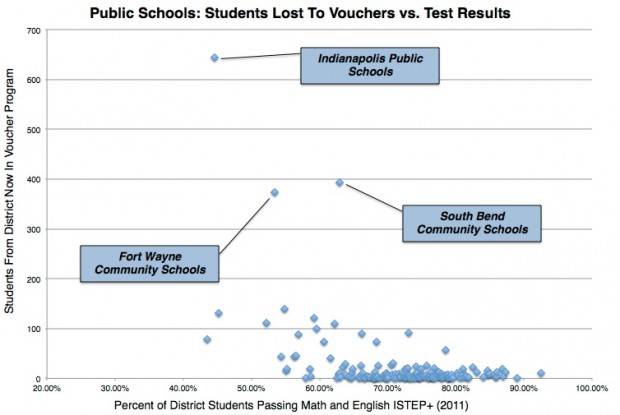Students Flee Districts With Lower Test Scores, But Voucher Schools Aren't Always Better

Kyle Stokes / StateImpact Indiana
A picture of Pope Benedict XVI hangs in the hallway of St. Thomas Aquinas School in Indianapolis.
Jeanetta White said in September she pulled her four foster kids out of South Bend public schools and enrolled them in parochial school with the help of Indiana’s new voucher program because she was fed up with the public schools’ performance.
“Why are parents taking kids out of public schools? There has to be something wrong,” White, 54, posited.
For the first time, the state released data on the voucher program Thursday confirming White was not alone in her thinking:
Three out of four students now enrolled in Indiana’s private school voucher program left a school district where fewer than 70 percent of students passed the state’s standardized tests, a StateImpact analysis of the data shows.
But are the private schools to which the 3,919 voucher program enrollees flocked — and to which $16.2 million in state money was redirected — any better? The data are much more mixed.
| Vouchers Accepted By ISTEP+ Passage Rate | |||
|---|---|---|---|
| Pass. Rate | Vouchers | Avg. Per School | Funding |
| 90-100% | 473 | 8.6 | $1,731,516 |
| 80-90% | 957 | 12.1 | $3,749,304 |
| 70-80% | 1120 | 28.7 | $4,707,348 |
| 60-70% | 247 | 27.4 | $991,520 |
| 0-60% | 162 | 27.0 | $699,676 |
| No Data | 979 | 18.8 | $4,499,810 |
| Vouchers Accepted By PL221 Letter Grade | |||
| Rating | Vouchers | Avg. Per School | Funding |
| A | 2655 | 15.5 | $11,052,769 |
| B | 455 | 15.2 | $1,867,648 |
| C | 65 | 13.0 | $272,419 |
| D | 58 | 29.0 | $250,271 |
| F | 11 | 11.0 | $49,500 |
| No Rating | 675 | 21.0 | $2,771,731 |
SOURCE: IDOE Data on Voucher Program, 2011 ISTEP+ Passage Rates
|
|||
Here’s what our analysis showed:
- Two-thirds of all voucher recipients attend non-public schools where 70 percent of students or more passed the state’s benchmark standardized test for Grades 3-8, the ISTEP+
- Less than two in five voucher recipients now attend schools where the ISTEP+ passage rate is better than 80 percent. (View in chart form here.)
- Based on the state’s letter grading system, 67.7 percent of voucher students attend an A school.
- On average, schools the state gave a C, D or F added 13 voucher students. That’s nearly as high as the average for schools receiving A’s or B’s, but not as high as the average bump in attendance for the school’s which did not receive a state letter grade at all.
- The state issued no letter grade rating or has no ISTEP+ data for 24 of the non-public schools now receiving vouchers. The state’s paying $1.8 million in tuition for the 455 students enrolled in these schools.
With 3,500 of the 7,500 available tuition scholarships unclaimed this year, Indiana’s voucher program is still far from the nation’s biggest. Unlike other programs, though, Indiana’s vouchers are available statewide to anyone fitting the program’s income requirements, even if they don’t live in a low-performing school district (like in Ohio or Wisconsin).
In a statement, state superintendent Tony Bennett heralded the benefits of opening up a free market for education.
“When you connect a child’s name and face to the Choice Scholarship [voucher] program, it is easy to see the transformational results of increased educational opportunities,” Bennett said.
But experts like Richard Lee Colvin, who runs the non-partisan think tank Education Sector, doubts whether vouchers improve student performance.
“There’s not ever been strong evidence that voucher students do better than students of similar incomes who remain in the public schools,” Colvin told StateImpact in September.
In chart form, the public schools’ losses to the voucher program looks roughly like this. The average district lost roughly 20 students, but many districts with ISTEP+ passage rates approaching 60 percent or lower lost many more students:



